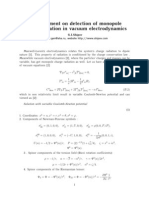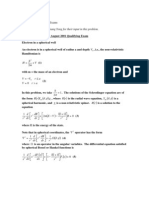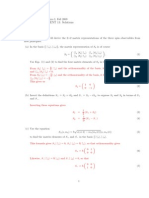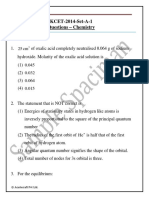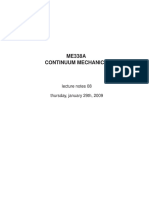4t6cn Tw9ab
4t6cn Tw9ab
Uploaded by
Mohsin MuhammadCopyright:
Available Formats
4t6cn Tw9ab
4t6cn Tw9ab
Uploaded by
Mohsin MuhammadOriginal Title
Copyright
Available Formats
Share this document
Did you find this document useful?
Is this content inappropriate?
Copyright:
Available Formats
4t6cn Tw9ab
4t6cn Tw9ab
Uploaded by
Mohsin MuhammadCopyright:
Available Formats
22 Spin Angular Momentum
The goal of this section is to introduce the spin angular momentum S, as a generalized angular
momentum operator that satises the general commutation relations S S = iS . The main dif-
ference between the angular momenta S, and L, is that S can have half-integer quantum numbers.
Note: Remember that the quantization rules established by the commutation relations did not rule
out the possibility of half-integer values for j. However, such possibility was ruled out by the
periodicity requirement, Y ( + 2) = Y (), associated with the eigenfunctions of L
z
and L
2
.
Since the spin eigenfunctions (i.e., the spinors) do not depend on spatial coordinates, they do not
have to satisfy any periodicity condition and therefore their eigenvalues can be half-integer.
Electron Spin:
A particular case of half-integer spin is the spin angular momentum of an electron with l = 1/2
(see Goudsmits historical recount of the discovery of the electron spin). In discussing the spin
properties of a particle we adopt the notation l = S, and m = m
s
.
The spin functions and are eigenfunctions of S
z
with eigenvalues +
1
2
and
1
2
, respectively.
These eigenfunctions are normalized according to,
1/2
ms=1/2
|(m
s
)|
2
= 1,
1/2
ms=1/2
|(m
s
)|
2
= 1, (61)
since m
s
can be either
1
2
, or
1
2
. Also, since the eigenfunctions and correspond to different
eigenvalues of S
z
, they must be orthogonal:
1/2
ms=1/2
(m
s
)(m
s
) = 0. (62)
In order to satisfy the conditions imposed by Eqs. (61) and (62),
(m
s
) =
ms,1/2
, and, (m
s
) =
ms,1/2
.
It is useful to dene the spin angular momentumladder operators, S
+
= S
x
+ iS
y
and S
= S
x
iS
y
.
Here, we prove that the raising operator S
+
satises the following equation:
S
+
= .
Proof:
Using the normalization condition introduced by Eq. ( 61) we obtain,
1/2
ms=1/2
(m
s
)(m
s
) =
1/2
ms=1/2
(
S
+
c
)
S
+
c
) = 1,
and
|c|
2
=
ms
(
S
+
)
S
x
+ i
S
y
).
57
Now, using the hermitian property of S
x
and S
y
,
ms
f
S
x
g =
ms
gS
x
f
,
we obtain:
|c|
2
=
ms
S
x
(S
+
)
+ iS
y
(S
+
)
,
where,
|c|
2
=
ms
S
x
S
+
i
S
y
S
+
,
|c|
2
=
ms
S
+
,
|c|
2
=
ms
(S
2
S
2
z
S
z
),
|c|
2
=
ms
(
3
4
2
4
+
2
2
),
|c|
2
=
2
.
Since the phase of c is arbitrary, we can choose c=.
Similarly, we obtain S
= .
Since is the eigenfunction with highest eigenvalue, the operator S
+
acting on it must annihilate
it as follows,
S
+
= 0, and S
= 0.
S
x
= (S
+
+ S
2
=
2
, S
x
=
1
2
.
S
y
= (S
+
S
2i
=
2i
, S
y
=
1
2
i.
Similarly, we nd S
x
=
1
2
, and S
y
=
1
2
i .
< |S
x
| >
0 /2
/2 0
< |S
y
| >
0 i/2
+i/2 0
< |S
z
| >
/2 0
0 /2
Therefore, S =
1
2
, where are the Pauli matrices dened as follows,
x
=
_
0 1
1 0
_
,
y
=
_
0 i
i 0
_
,
z
=
_
1 0
0 1
_
,
where,
2
x
=
2
y
=
2
z
= 1.
58
22.1 Exercise 25
Prove that the Pauli matrices anti-commute with each other, i.e.,
j
+
j
i
= 0,
where i = j, and i, j = (x, y, z).
In order to nd the eigenfunctions of S
z
, called eigenspinors, consider the following eigenvalue
problem:
S
z
_
u
_
=
2
_
u
_
,
_
1 0
0 1
__
u
_
=
_
u
_
,
_
u
_
=
_
u
_
,
_
u
+
v
+
_
=
_
u
+
v
+
_
, v
+
= 0 , u
+
= 1 .
Similarly we obtain, u
= 0 , and v
= 1 . Therefore, electron eigenspinors satisfy the eigen-
value problem,
S
z
,
with,
=
_
0
1
_
, and
+
=
_
1
0
_
.
Any spinor can be expanded in the complete set of eigenspinors as follows,
_
+
_
=
+
_
1
0
_
+
_
0
1
_
,
where |
+
|
2
, and |
|
2
, are the probabilities that a measurement of S
z
yields the value +
1
2
, and
1
2
, respectively, when the system is described by state
_
+
_
.
22.2 Exercise 26
Prove that, S
2
+
=
2
2
(
1
2
+ 1)
+
.
59
22.3 Exercise 27
Consider an electron localized at a crystal site. Assume that the spin is the only degree of freedom
of the system and that due to the spin the electron has a magnetic moment,
M =
eg
2mc
S,
where g 2, m is the electron mass, e is the electric charge and c is the speed of light. Therefore,
in the presence of an external magnetic eld B the Hamiltonian of the system is,
H = M B.
Assume that B points in the z direction and that the state of the system is,
(t) = e
it
_
+
_
.
Consider that initially (i.e., at time t = 0) the spin points in the x direction (i.e., the spinor is an
eigenstate of
x
with eigenvalue
1
2
).
Compute the expectation values of S
x
and S
y
at time t.
Addition of Angular Momenta
Since L depends on spatial coordinates and S does not, then the two operators commute (i.e.,
[L, S] = 0). It is, therefore, evident that the components of the total angular momentum,
J = L + S,
satisfy the commutation relations,
J J = iJ.
Eigenfunctions of J
2
and J
z
are obtained from the individual eigenfunctions of two angular mo-
mentum operators L
1
and L
2
with quantum numbers (l
1
, m
1
) and (l
2
, m
2
), respectively, as follows:
m
j
=
l
1
,m
1
,l
2
,m
2
C(jm, l
1
m
1
l
2
m
2
)
. .
m
1
l
1
m
2
l
2
,
Clebsch-Gordan Coefcients
where,
J
2
jm
=
2
j(j + 1)
jm
,
J
z
jm
= m
jm
.
60
22.4 Exercise 28
Show that,
m+1/2
j
= C
1
Y
m
l
+
+ C
2
Y
m+1
l
, is a common eigenfunction of J
2
and J
z
when,
C
1
=
_
l+m+1
2l+1
, and C
2
=
_
lm
2l+1
, or when, C
1
=
_
lm
2l+1
, and C
2
=
_
l+m+1
2l+1
.
Hint: Analyze the particular case j = l 1/2, and j = l + 1/2. Note that,
J
2
= L
2
+ S
2
+ 2LS = L
2
+ S
2
+ 2L
z
S
z
+ L
+
S
+ L
S
+
,
J
z
= L
z
+ S
z
,
23 Central Potential
Consider a two-particle system represented by the following diagram,R1(123) R3(168)
6
-
.
.
.
.
.
.
.
.
.
.
.
.
.
.
.
.
.
.
.
.
.
.
.
.
.
.
.
.
.
.
.
.
.
.
.
.
.
.
.
.
.
.
.
.
.
.
................................
.
.
.
.
.
.
.
.
.
.
.
.
.
.
.
.
.
.
.
.
.
.
.
.
.
.
.
.
.
:
X
X
X
X
X
Xz
x
y
z
x
1
y
1
z
1
m
1
m
2
r
1
r
r
2
u
u
where x, y and z represent distances between the two particles along the three Cartesian axes,
where r = (x, y, z) = r
2
r
1
, with r
1
and r
2
the position vectors of particles 1 and 2, respectively.
The central potential V (x, y, z) is a function of | r| =
_
x
2
+ y
2
+ z
2
, rather than a function of the
individual Cartesian components. Assuming that such function denes the interaction between the
two particles, the Hamiltonian of the system has the form,
H =
P
2
1
2m
1
+
P
2
2
2m
2
+ V (|r
2
r
1
|) = T + V (|r
2
r
1
|),
where, T =
m
1
2
|
r
1
|
2
+
m
2
2
|
r
2
|
2
, with |
r
1
|
2
=
r
1
r
1
.
Changing variables r
1
, and r
2
, by the center-of-mass coordinates
R, and the relative coordinates,
r = r
2
r
1
, where,
R
m
1
r
1
+ m
2
r
2
m
1
+ m
2
; r = r
2
r
1
,
we obtain,
r
1
=
R
m
2
m
1
+ m
2
r, r
2
=
R +
m
1
m
1
+ m
2
r.
61
Therefore,
T =
m
1
2
_
R
m
2
m
1
+ m
2
r
__
R
m
2
m
1
+ m
2
r
_
+
m
2
2
_
R +
m
1
m
1
+ m
2
r
__
R +
m
1
m
1
+ m
2
r
_
,
or,
T =
m
1
+ m
2
2
|
R|
2
+
1
2
m
1
m
2
m
1
+ m
2
|
r|
2
=
1
2
M|
R|
2
+
1
2
|
r|
2
,
where M = m
1
+ m
2
is the total mass of the system, and
m
1
m
2
m
1
+m
2
is the reduced mass of the
two-particle system. Therefore, the total Hamiltonian of the system can be written as follows,
H =
1
2
M|
R|
2
+
1
2
|
r|
2
+ V (|r|) =
P
2
M
2M
+
P
2
2
+ V (|r|),
where the rst term corresponds to the kinetic energy of a particle of mass M, and the second
and third terms constitute the Hamiltonian of a single particle with coordinates r. Therefore, the
time-independent Schr odinger equation for the system is,
_
P
2
M
2M
+
P
2
2
+ V (|r|)
_
(
R, r) = E(
R, r).
Trying a factorizable solution, by separation of variables,
(r,
R) =
(r)
M
(
R),
we obtain,
R
2
M
2M
. .
r
2
M
2
+
M
V (|r|)
. .
= E
M
.
depends on R depends on r
Therefore, each one of the parts of the Hamiltonian have to be equal to a constant,
2
2M
1
R
2
M
= E
M
, (63)
2
2
1
r
2
+ V (|r|) = E
, with E
M
+ E
= E. (64)
Eq. (64) is the Schr odinger equation for a free particle with mass M. The solution of such equation
is,
M
(R) = (2)
3/2
e
i
k
R
, where
|
k|
2
2
2M
= E
M
. (65)
According to Eq. (65), the energy E
is found by solving the equation,
2
2
r
2
+ V (| r|)
= E
. (66)
62
Equations ((65)) and ((66)) have separated the problem of two particles interacting according to a
central potential V (| r
2
r
1
|) into two separate one-particle problems that include:
(1) The translational motion of the entire system of mass M.
(2) The relative (e.g., internal) motion.
These results apply to any problem described by a central potential (e.g., the hydrogen atom, the
two-particle rigid rotor, and the isotropic multidimensional harmonic-oscillator).
Consider Eq. (66), with
2
2
x
2
+
2
y
2
+
2
z
2
, and V (| r|) a spherically-symmetric potential, i.e.,
a function of the distance r = | r|. It is natural to work in spherical coordinates.
23.1 Exercise 29
Prove that the Laplacian
2
can written in spherical coordinates as follows,
2
=
2
r
2
+
2
r
r
1
r
2
L
2
, where
L
2
=
2
_
2
2
+
Cos
sin
+
1
sin
2
2
_
.
It is important to note that the commutator
[
2
, L
2
] =
_
2
r
2
+
2
r
r
,
L
2
_
_
1
r
2
L
2
,
L
2
_
= 0,
because
L
2
does not involve r, but only and . Also, since
L
2
does not involve r, and V is a
function of r,
[V, L
2
] = 0.
Consequently,
[H, L
2
] = 0,
whenever the potential energy of the systemis dened by a central potential. Furthermore, [H, L
z
] =
0, because
L
z
= i
.
Conclusion: A system described by a central-potential has eigenfunctions that are common to the
operators H, L
2
and L
Z
:
= E
L
2
=
2
l(l + 1)
, l = 0, 1, 2, ...
L
z
= m
, m = l, l + 1, ..., l.
Substituting these results into Eq. (66) we obtain,
2
2
_
2
r
2
+
2
r
r
_
+
2
2
2
r
2
2
l(l + 1)
+ V (| r|)
= E
.
Since the eigenfunctions of
L
2
are spherical harmonics Y
m
l
(, ), we consider the solution,
= R(r)Y
m
l
(, ),
63
and we nd that R(r) must satisfy the equation,
2
2
_
2
R
r
2
+
2
r
R
r
_
+
2
2r
2
l(l + 1)R + V (| r|)R = E
R. (67)
24 Two-Particle Rigid-Rotor
The rigid-rotor is a system of two particles for which the distance between them| r| = d is constant.
The Hamiltonian of the system is described by Eq. (67), where the rst two terms are equal to zero,
and E
=
2
2d
2
l(l + 1) + V (d), with
= Y
m
l
(, ).
The moment of inertia of a system of particles is I
2
i=1
m
i
r
2
i
, where m
i
is the mass of particle
i and r
i
is the particle distance to the axis.
24.1 Exercise 30
Prove that I = d
2
for the two-particle rigid rotor, where =
m
1
m
2
m
1
+m
2
, d = r
2
r
1
, and is an axis
with the center of mass of the system and is perpendicular to the axis that has the center of mass of
both particles. Assume that the center of mass lies at the origin of coordinates, and that the x axis
has the center of mass of both particles in the system.
The rotational energy levels of the rigid rotor are:
E
=
2
2I
l(l + 1), with l = 0, 1, 2, ... (68)
These energy levels usually give a good approximation of the rotational energy levels of di-
atomic molecules (e.g., the HCl molecule).
25 Problem Set
25.1 Exercise 31
Solve problems 6.5 and 6.6 of reference 1.
25.2 Exercise 32
Prove that the angular momentum operator L = r p is hermitian.
64
25.3 Exercise 33
Prove that,
(x + a) = e
(i/)ap
(x),
where p = i/x, and a is a nite displacement.
25.4 Exercise 34
Let
H be the Hamiltonian operator of a system. Denote
k
the eigenfunctions of
H with eigenval-
ues E
k
. Prove that <
n
|[
Q,
H]|
k
>= 0, for any arbitrary operator
Q, when n = k.
25.5 Exercise 35
Prove that,
[x, H] = ip/m,
where, H = p
2
/(2m) + V (x).
25.6 Exercise 36
Prove that,
L
Y
m
l
=
_
(l + m)(l m + 1)Y
m1
l
,
where L
z
Y
m
l
= mY
m
l
, and L
2
Y
m
l
=
2
l(l + 1)Y
m
l
.
25.7 Exercise 37
Consider a system described by the Hamiltonian matrix,
H =
_
E
0
E
0
_
,
where the matrix elements H
jk
=<
j
|
H|
k
>. Consider that the system is initially prepared in
the ground state, and is then inuenced by the perturbation W(t) dened as follows,
W(t) =
_
0 e
t
2
/
2
it
e
t
2
/
2
+it
0
_
.
Calculate the probability of nding the system in the excited state at time t >> .
65
You might also like
- Chapter 01,02 - Solutions Goldstein ManualDocument8 pagesChapter 01,02 - Solutions Goldstein ManualLia Meww100% (2)
- Goldstein 18 21 13 14 20Document15 pagesGoldstein 18 21 13 14 20Abdul Shakoor ButtNo ratings yet
- Sol03 Landau LevelsDocument8 pagesSol03 Landau LevelsPrashant SharmaNo ratings yet
- HW 9 SolutionDocument5 pagesHW 9 SolutionJuan DavidNo ratings yet
- Management: A Global, Innovative, and Entrepreneurial Perspective by WeihrichDocument3 pagesManagement: A Global, Innovative, and Entrepreneurial Perspective by WeihrichNusrat Jahan0% (1)
- Homework 10Document7 pagesHomework 10Ale GomezNo ratings yet
- Spin31 MarchDocument18 pagesSpin31 MarchF0x123No ratings yet
- Quantum Mechanics - Homework Assignment 3: Alejandro G Omez Espinosa October 8, 2012Document7 pagesQuantum Mechanics - Homework Assignment 3: Alejandro G Omez Espinosa October 8, 2012Ale GomezNo ratings yet
- Preguntas Resueltas PDFDocument46 pagesPreguntas Resueltas PDFJustin BullockNo ratings yet
- Homework 4Document7 pagesHomework 4Ale Gomez100% (1)
- Homework 7Document7 pagesHomework 7Ale Gomez100% (5)
- 1 The Dirac Field and Lorentz Invariance: Soper@bovine - Uoregon.eduDocument15 pages1 The Dirac Field and Lorentz Invariance: Soper@bovine - Uoregon.eduFasiMalikNo ratings yet
- Relativistic Quantum Mechanics IntroDocument33 pagesRelativistic Quantum Mechanics IntroATP_101No ratings yet
- TIPT2Document9 pagesTIPT2cuongspvl2713No ratings yet
- Solut Tent SG2150 Feb 12Document5 pagesSolut Tent SG2150 Feb 12Droffilc Nav Cm MulihamNo ratings yet
- 16.4. Problem Set Iv 220 Answers: Problem Set IV: D DT MDocument5 pages16.4. Problem Set Iv 220 Answers: Problem Set IV: D DT MShweta SridharNo ratings yet
- QFT Example Sheet 1 Solutions PDFDocument13 pagesQFT Example Sheet 1 Solutions PDFafaf_physNo ratings yet
- tmpABED TMPDocument5 pagestmpABED TMPFrontiersNo ratings yet
- Quantum Mechanics II - Homework 2Document6 pagesQuantum Mechanics II - Homework 2Ale GomezNo ratings yet
- Homework 3Document7 pagesHomework 3Ale Gomez100% (5)
- 7a6i3 0e7yyDocument10 pages7a6i3 0e7yyMohsin MuhammadNo ratings yet
- DRM SolutionsDocument116 pagesDRM SolutionsCésar TapiaNo ratings yet
- Mit Double PedulumDocument13 pagesMit Double PedulumAntoineNo ratings yet
- Motion in Central Force FieldDocument10 pagesMotion in Central Force Fieldmohit4physicsNo ratings yet
- Questions: Course 241: Advanced MechanicsDocument25 pagesQuestions: Course 241: Advanced Mechanicshmalrizzo469No ratings yet
- Final Exam, Quantum Mechanics 501, Rutgers: December 17, 2014Document2 pagesFinal Exam, Quantum Mechanics 501, Rutgers: December 17, 2014Anderson Vergaray AcevedoNo ratings yet
- Mathematical Modeling of Mechanical Systems and Electrical SystemsDocument49 pagesMathematical Modeling of Mechanical Systems and Electrical SystemsMary DunhamNo ratings yet
- The Non Linear Advection Equation (Inviscid Burgers Equation)Document6 pagesThe Non Linear Advection Equation (Inviscid Burgers Equation)linoNo ratings yet
- Quantum Mechanics I Solutions 6.: HintDocument12 pagesQuantum Mechanics I Solutions 6.: HintShweta SridharNo ratings yet
- Relativistic Astrophysics. 2009. Course Work 5. Solutions: X X 2 X X 2 2Document5 pagesRelativistic Astrophysics. 2009. Course Work 5. Solutions: X X 2 X X 2 2ShootingStarPhotonsNo ratings yet
- Homework 9Document7 pagesHomework 9Ale GomezNo ratings yet
- Workshop 10 SolutionsDocument4 pagesWorkshop 10 SolutionsSteve DruryNo ratings yet
- Spin HalfDocument12 pagesSpin HalfJorge Mario Durango PetroNo ratings yet
- Hw4 SolutionsDocument7 pagesHw4 SolutionsAn Nahl100% (1)
- Elementary Tutorial: Fundamentals of Linear VibrationsDocument51 pagesElementary Tutorial: Fundamentals of Linear VibrationsfujinyuanNo ratings yet
- ME4213 Tutorial 2bDocument4 pagesME4213 Tutorial 2bLinShaodunNo ratings yet
- Mekanika Benda TegarDocument4 pagesMekanika Benda TegarAhmad PohanNo ratings yet
- Modal AnalysisDocument40 pagesModal AnalysisSumit Thakur100% (1)
- 67006d484eb67b93826eb560_76255608289Document2 pages67006d484eb67b93826eb560_76255608289syedaafifajilaniNo ratings yet
- EmonopolDocument3 pagesEmonopolFlavio FontanaNo ratings yet
- Quality Solutions GoldsteinDocument7 pagesQuality Solutions GoldsteinJohn HolmanNo ratings yet
- PHY2014F Buffler VW1Document125 pagesPHY2014F Buffler VW1Matthew BaileyNo ratings yet
- Some Examples. Constraints and Lagrange MultipliersDocument15 pagesSome Examples. Constraints and Lagrange MultipliersGuillermoEatonNo ratings yet
- Vibration of Two Degree of Freedom SystemDocument23 pagesVibration of Two Degree of Freedom SystemDewa Ayu Mery AgustinNo ratings yet
- Tempspin 2Document5 pagesTempspin 2Jarryd RastiNo ratings yet
- Thanks To Yossef and Shiang Yong For Their Input in This ProblemDocument8 pagesThanks To Yossef and Shiang Yong For Their Input in This ProblemIgnacio JuárezNo ratings yet
- 851HW13 09solutionsDocument13 pages851HW13 09solutionsBrunna TomNo ratings yet
- Chapter 1: General Properties of Angular Momentum in Quantum MechanicsDocument102 pagesChapter 1: General Properties of Angular Momentum in Quantum MechanicsATP_101No ratings yet
- 105 FfsDocument8 pages105 Ffsskw1990No ratings yet
- Classical Mechanics NotesDocument54 pagesClassical Mechanics NotesAmichai LevyNo ratings yet
- A Semi-Classical Approach To The Jaynes-Cummings ModelDocument31 pagesA Semi-Classical Approach To The Jaynes-Cummings Modelharry37No ratings yet
- Student Solutions Manual to Accompany Economic Dynamics in Discrete Time, second editionFrom EverandStudent Solutions Manual to Accompany Economic Dynamics in Discrete Time, second editionRating: 4.5 out of 5 stars4.5/5 (2)
- Mathematics 1St First Order Linear Differential Equations 2Nd Second Order Linear Differential Equations Laplace Fourier Bessel MathematicsFrom EverandMathematics 1St First Order Linear Differential Equations 2Nd Second Order Linear Differential Equations Laplace Fourier Bessel MathematicsNo ratings yet
- 38.1 Restricted Closed Shell Hartree-Fock: XX XX XX XX X XX XX XX XX XDocument10 pages38.1 Restricted Closed Shell Hartree-Fock: XX XX XX XX X XX XX XX XX XMohsin MuhammadNo ratings yet
- Gjmuc v5q55Document10 pagesGjmuc v5q55Mohsin MuhammadNo ratings yet
- 13 Time Dependent Perturbation TheoryDocument9 pages13 Time Dependent Perturbation TheoryMohsin MuhammadNo ratings yet
- Diq1m w8jrhDocument10 pagesDiq1m w8jrhMohsin MuhammadNo ratings yet
- Cyi3b YveqbDocument10 pagesCyi3b YveqbMohsin MuhammadNo ratings yet
- The Fundamental Postulates of Quantum MechanicsDocument11 pagesThe Fundamental Postulates of Quantum MechanicsMohsin MuhammadNo ratings yet
- 7a6i3 0e7yyDocument10 pages7a6i3 0e7yyMohsin MuhammadNo ratings yet
- SOP-BUT-002 - How To Handle ArrivalsDocument3 pagesSOP-BUT-002 - How To Handle ArrivalsCengiz ŞentürkNo ratings yet
- Acetylcysteine Drug StudyDocument2 pagesAcetylcysteine Drug StudyJulienFrayNo ratings yet
- Liu2016 CelluloseDocument15 pagesLiu2016 Cellulosejeamnard balitaanNo ratings yet
- Study of Reliability Analysis of CVT SystemDocument13 pagesStudy of Reliability Analysis of CVT Systemswapnil pandeNo ratings yet
- IEC 61850 As Backbone For Smart PAC Systems: Klaus-Peter Brand, Fellow, IEEEDocument8 pagesIEC 61850 As Backbone For Smart PAC Systems: Klaus-Peter Brand, Fellow, IEEEengkankwNo ratings yet
- KCET-2014-Set-A-1 Questions - Chemistry: © Acadecraft PVT LTDDocument54 pagesKCET-2014-Set-A-1 Questions - Chemistry: © Acadecraft PVT LTDNaveen GuptaNo ratings yet
- Volumetric-Deviatoric DecompositionDocument9 pagesVolumetric-Deviatoric DecompositionSüleyman TüreNo ratings yet
- 45 Liter Insufflator: Finding PneumoDocument4 pages45 Liter Insufflator: Finding PneumoMohammed SairawanNo ratings yet
- A Study On Influence of Density and Viscosity of Emulsion Explosive On Its Detonation VelocityDocument21 pagesA Study On Influence of Density and Viscosity of Emulsion Explosive On Its Detonation VelocityKushana SaikirannNo ratings yet
- II bcom-LABPROGRAMSDocument42 pagesII bcom-LABPROGRAMSecommercejvsNo ratings yet
- Project 20-Pollution Due To FestivalsDocument6 pagesProject 20-Pollution Due To FestivalsUjjval Nagota100% (1)
- 1 s2.0 S0263224116306157 MainDocument7 pages1 s2.0 S0263224116306157 MainbatuhanNo ratings yet
- Vane Pumps-1 PDFDocument83 pagesVane Pumps-1 PDFMusaferNo ratings yet
- Kollicream-3c Technical InformationDocument13 pagesKollicream-3c Technical InformationRockstarNo ratings yet
- India Sails Through: India's Deepest Solar Eclipse On SundayDocument2 pagesIndia Sails Through: India's Deepest Solar Eclipse On SundayDr. KaarthikaNo ratings yet
- MS-01-140 Gaugeable Tube Fittings PDFDocument56 pagesMS-01-140 Gaugeable Tube Fittings PDFRyu MorganNo ratings yet
- High Pressure Lift Ejector and Liquid Ejector Systems: Application GuideDocument28 pagesHigh Pressure Lift Ejector and Liquid Ejector Systems: Application Guidejvc hemitNo ratings yet
- Matrix Operations C ProgramDocument10 pagesMatrix Operations C ProgramMark Charles TarrozaNo ratings yet
- The Philosophy and Symbolism of FreemasonryDocument10 pagesThe Philosophy and Symbolism of FreemasonryAngelyn Zednanreh Betiola100% (1)
- 03 Lomozik Creep-Resisting Structural Steels For The Power Industry-The Past and The Present TimeDocument8 pages03 Lomozik Creep-Resisting Structural Steels For The Power Industry-The Past and The Present TimeTibor KeményNo ratings yet
- Construction Safety and Health ManualDocument26 pagesConstruction Safety and Health ManualCCT18-20 NMAMITNo ratings yet
- Green Accounting and Firm Performance in NigeriaDocument10 pagesGreen Accounting and Firm Performance in NigeriaEditor IJTSRDNo ratings yet
- EFI Group Cost Estimate For Mitigating Project RiskDocument22 pagesEFI Group Cost Estimate For Mitigating Project RiskJefferson Ayubo BroncanoNo ratings yet
- 24chapter - Plotoutline ENDDocument49 pages24chapter - Plotoutline ENDMr Who616No ratings yet
- History of Violin Making in Poland: Written by Jan BobakDocument7 pagesHistory of Violin Making in Poland: Written by Jan BobakSantino godfather sonNo ratings yet
- Contoh Descriptive Text Tentang Borobudur TempleDocument3 pagesContoh Descriptive Text Tentang Borobudur Templejemi100% (3)
- Yanmar SV-08Document90 pagesYanmar SV-08Amarildo Júnior100% (1)
- I94i) Book Reviews: Convergence and Uniformity in Topology. by J. W. Tukey. Annals ofDocument2 pagesI94i) Book Reviews: Convergence and Uniformity in Topology. by J. W. Tukey. Annals ofSong LiNo ratings yet
- Jesus No WifeDocument109 pagesJesus No Wifeakylla8599100% (1)







































